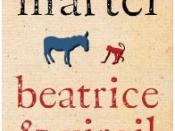In the novel Life of Pi, Yann Martel uses indirect characterization to portray how the harshest elements can bring out the most primal instincts in man, and the unexpected cooperation in the most primal of animals. This is used to symbolize the close similarities in the behavior of man and animal, although seemingly worlds apart at first glace. It is a constant switch between Pi's thoughts and Pi's actions that is needed to extend this characterization to the fullest. Martel does this by showing Pi's religious and peaceful vegetarian personality in the beginning of the novel; one that wouldn't even drink milk because it came from an animal. Yet when the time comes to survive he shows much less compassionate actions, one fueled by starvation and the will to live. This characterization wouldn't have been fully accomplished in the readers' mind without strong imagery as well. The relentless sun cast over the lifeboat along with the deep blue unforgiving sea is able to help the reader envision the intense wear down of Pi's outer shell and revealing his inner primal core.
Martel uses imagery to compliment the characterization of the tiger Richard Parker as well. The ferocity wouldn't be nearly as fervent without the image of a 450 pound Bengal tiger with a vigorous orange coat complemented with striking black stripes. These characteristics will drag the reader to a higher level of interest than a basic description alone, as well as a better understanding of the tiger's sheer strength and beauty.
Pi was afraid of Richard Parker more than anything else in the beginning of his voyage through the ocean, for it was the only thing he had known to be afraid of. His entire life had been serene, only being warned of the dangerousness of animals while tending the...


